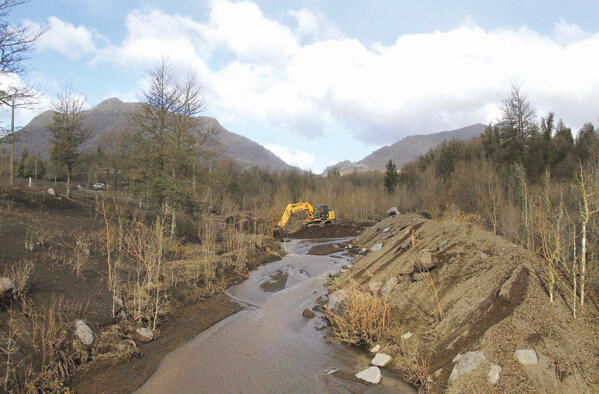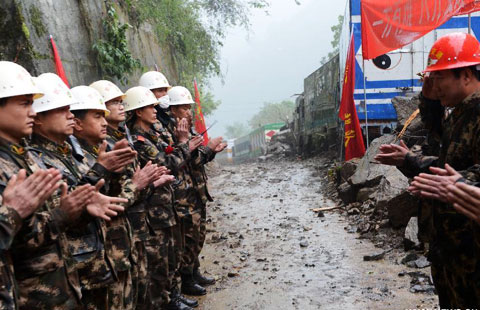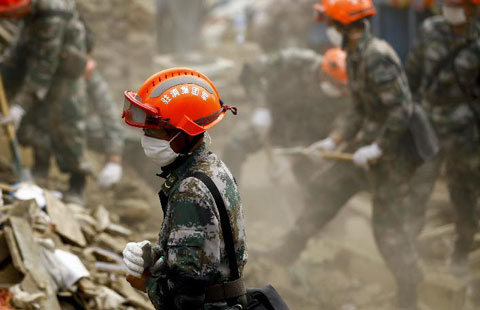Chile volcano Calbuco erupts again with new cloud of ash
Updated: 2015-05-04 05:10
(Agencies)
|
||||||||
 |
|
An excavator works on a river affected by ashes from Calbuco Volcano in El Tepu town on May 2. Chilean volcano Calbuco erupted for the third time in eight days on April 29, sending a new cloud of ash and gas high into the sky, although officials said the latest eruption was less powerful than those of last week. [REUTERS / CARLOS GUTIERREZ] |
Chilean volcano Calbuco erupted for the third time in eight days on April 29, sending a new cloud of ash and gas high into the sky, although officials said the latest eruption was less powerful than those of last week.
Calbuco spewed more than 200 million tons of ash last week, coating nearby towns, wrecking parts of the salmon industry and forcing the cancellation of flights as far as Buenos Aires 1,400 km away.
The volcano has been quiet this week, but geological officials had warned it was still unstable and could erupt again. The new eruption began at 1:09 pm (1609 GMT), the government's geology service Sernageomin said.
Calbuco, one of the most active along a chain of around 2,000 in Chile, is in the scenic Los Lagos region, a popular tourist destination around 1,000 km south of the capital, Santiago.
TV pictures showed a thick, grey plume spreading quickly into the sky on April 29 afternoon. It was heading south-east over the Andes intoArgentina, said government meteorologist Arnaldo Zuniga.
LATAM Airlines' Chilean arm LAN, which cancelled some flights last week as a precaution because of the ash cloud, said flights in Chile andArgentina were unaffected so far.
A 20-km exclusion zone has remained in place around the volcano since the first sudden eruption on April 22, but some residents have been making short visits to their homes to begin clearing away thick layers of ash and debris.
About 1,500 more people had been evacuated on April 29, interior minister Mahmud Aleuy said. He said there were indications that the eruption was not as powerful as those of last week, when ash and gas reached 17 km into the atmosphere.
"This emission is notably weaker than the previous ones. We are talking about a column of ash no higher than four kilometers," said Aleuy.
Officials said, however, that heavy rain or snow on Friday could lead to complications such as lahares - destructive flows of debris that can wipe out anything in their path.
"This emission should begin to weaken in the coming hours...but we are in an eruptive process, on red alert, and the situation can change at any time," said Sernageomin head Rodrigo Alvarez.

 China pavilion opens at Expo Milano 2015
China pavilion opens at Expo Milano 2015 New exhibition by Fondazione Prada offers new perspective on originality and imitation
New exhibition by Fondazione Prada offers new perspective on originality and imitation
 Mayweather beats Pacquiao by unanimous decision
Mayweather beats Pacquiao by unanimous decision
 Newborn British princess makes first appearance with royal
Newborn British princess makes first appearance with royal
 Quake-hit China-Nepal highway cleared
Quake-hit China-Nepal highway cleared
 Highlights of Milan Expo 2015
Highlights of Milan Expo 2015
 Twins festival kicks off in Yunnan
Twins festival kicks off in Yunnan
 Chinese rescuers work on outskirts of Kathmandu, Nepal
Chinese rescuers work on outskirts of Kathmandu, Nepal
Most Viewed
Editor's Picks

|

|

|

|

|

|
Today's Top News
More speculation in China's market as it's new
Consul general praises Beijing university to alumni
Manufacturing hub starts work on first zero-labor factory
New York City police officer shot in head while conducting patrol
Putin ratifies east-route gas pipeline agreement with China
Britain has a new princess and eagerly awaits her name
UK's Duchess Kate gives birth to a daughter
Nepal President expresses gratitude for China's quake relief work
US Weekly

|

|






